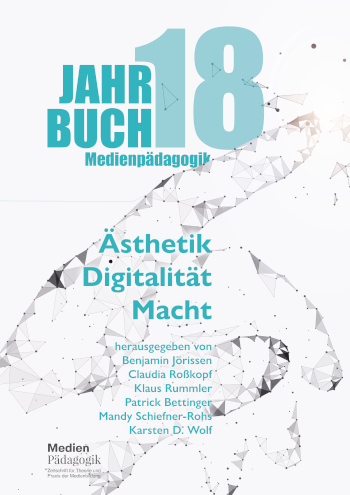Abstract
This contribution documents – especially visually – impressions, observations and results from an online workshop «Interaction and Participation in Cultural Education», which aimed to present topics, working methods and principles of the research cluster. It made sense to conceptualize the workshop itself in an interactive and participative manner, as well as along the theme of the framing conference. A large part of the communication is shifted to a digital whiteboard parallel to the video conference, on which all participants can act individually and together. Central fragments from a text of the cluster are available as material, in which the terms interaction and participation are negotiated in a joint self-experiment and guided by the principle of collage. The text principle becomes the operating principle of the workshop: The participants are exposed to the attempt to create collages themselves in small groups on the digital whiteboard using both the provided and their own material. In the experimental format of the workshop, an aesthetic-digital space of possibility and experience is contoured performatively, in which the individual positions and perspectives of all participants interactively enter into networked forms of articulation via text, image and language. In the resulting collages, aspects of aesthetics, digitality and power come into play in an impressive way.
References
Bourriaud, Nicolas. 2002. Postproduction. Culture as Screenplay: How Art Reprograms the World. New York: has & sternberg.
Brinkmann, Malte. 2015. «Übungen der Aufmerksamkeit. Phänomenologische und empirische Analysen zum Aufmerksamwerden und Aufmerksammachen». In Aufmerksamkeit: Geschichte – Theorie – Empirie, herausgegeben von Sabine Reh, Kathrin Berdelmann, und Jörg Dinkelaker, 199–220. Wiesbaden: Springer Fachmedien. https://doi.org/10.1007/978-3-531-19381-6_11.
Braun, Tom, und Kirsten Witt, Hrsg. 2017. Illusion Partizipation – Zukunft Partizipation. (wie) macht Kulturelle Bildung unsere Gesellschaft jugendgerechter?, Kulturelle Bildung, 54 München: kopaed.
Büro trafo.K. 2020. «Umdeuten. Vermittlung als kollaborative Lust an der Verschiebung des Selbstverständlichen». In vermittlung vermitteln: Fragen, Forderungen und Versuchsanordnungen von Kunstvermittler*innen im 21. Jahrhundert, herausgegeben von Ayşe Güleç, Carina Herring, Gila Kolb, Nora Sternfeld, und Julia Stolba, 120-131 Berlin: nGbK. https://documenta-studien.de/media/1/vermittlung/Vermittlung_vermitteln.pdf.
Hallmann, Kerstin, Fabian Hofmann, Jessica Knauer, Astrid Lembcke-Thiel, Kristine Preuß, Claudia Roßkopf, und Miriam Schmidt-Wetzel. 2021. «Interaktion und Partizipation als Handlungsprinzip – Ein gemeinsamer Selbstversuch». Kulturelle Bildung Online – kubi-online.de. https://doi.org/10.25529/5AN8-M388.
Haraway, Donna. 1988. «Situated Knowledges: The Science Question in Feminism and the Privilege of Partial Perspective». Feminist Studies 14 (3): 575. https://doi.org/10.2307/3178066.
Hoppe, Katharina, und Thomas Lemke. 2021. Neue Materialismen zur Einführung. Hamburg. Junius.
Jörissen, Benjamin. 2017. «Digital/kulturelle Bildung. Plädoyer für eine Pädagogik der ästhetischen Reflexion digitaler Kultur». Herausgegeben von Torsten Meyer, Julia Dick, Peter Moormann, und Julia Ziegenbein. Zeitschrift Kunst Medien Bildung | zkmb. http://zkmb.de/digitalkulturelle-bildung-plaedoyer-fuer-eine-paedagogik-der-aesthetischen-reflexion-digitaler-kultur/.
Kholeif, Omar. 2018. Goodbye, world! looking at art in the digital age. Berlin: Sternberg Press.
Mersch, Dieter. 2015. Epistemologie des Ästhetischen. Zürich: Diaphanes.
Pazzini, Karl-Josef. 1986. «Collage». Kunst + Unterricht 100, 20-24.
Salen, Katie, und Eric Zimmerman. 2003. Rules of play: game design fundamentals. Cambridge, Mass: MIT Press.
Stalder, Felix. 2009. «Neun Thesen zur Remix-Kultur», irights.info. https://irights.info/wp-content/uploads/fileadmin/texte/material/Stalder_Remixing.pdf.
Stalder, Felix. 2016. Kultur der Digitalität. Berlin: Suhrkamp.
Zahn, Manuel. 2015. «Remixkultur und Kunstpädagogik». In What’s next? Art Education: Ein Reader, herausgegeben von Torsten Meyer und Gila Kolb. 2. München: kopaed.

